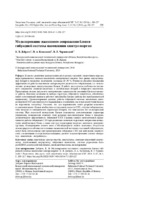| dc.contributor.author | Добрего, К. В. | |
| dc.contributor.author | Козначеев, И. А. | |
| dc.contributor.author | Червинский, В. Л. | |
| dc.coverage.spatial | Минск | ru |
| dc.date.accessioned | 2024-07-01T09:26:31Z | |
| dc.date.available | 2024-07-01T09:26:31Z | |
| dc.date.issued | 2024 | |
| dc.identifier.citation | Добрего, К. В. Моделирование пассивного сопряжения блоков гибридной системы накопления электроэнергии = Мodelling of Passive Coupling of Battery Units of Hybrid Energy Storage System / К. В. Добрего, И. А. Козначеев, В. Л. Червинский // Известия высших учебных заведений и энергетических объединений СНГ. Энергетика. – 2024. – № 3. – С. 209-227. | ru |
| dc.identifier.uri | https://rep.bntu.by/handle/data/145783 | |
| dc.description.abstract | В связи с развитием электротранспорта и ростом «зеленой» энергетики в мире все шире применяются системы накопления электрической энергии. Рост рынка аккумуляторных батарей в последнее десятилетие составлял 20–30 %. Одним из способов повышения эффективности работы накопителя электроэнергии является его гибридизация, т.е. использование разнородных аккумуляторных блоков. В работе исследуются особенности пассивного сопряжения свинцово-кислотных и литий-ионных батарей в гибридном накопителе. Представлена модель для расчета электрических характеристик указанных блоков в процессе работы. Показана возможность выбора структуры гибридного накопителя, обеспечивающей сопоставимый диапазон рабочего напряжения блоков (работы без преобразователей напряжения). Промоделированы режимы работы гибридной системы накопления электроэнергии (СНЭ) как при простом параллельном соединении, так и при коммутации блоков по пороговому алгоритму. Показано, что для выравнивания темпа разрядки основного и дополнительного блоков необходимо согласование емкости СНЭ, степени гибридизации, типа нагрузки и электрических параметров батарей, что невозможно без моделирования системы. При пороговой коммутации блоков появляются дополнительные параметры управления, позволяющие изменять темп разрядки дополнительного блока и повышать экономическую эффективность гибридной СНЭ. Сделаны оценки экономической эффективности работы гибридных СНЭ при различных значениях порогового напряжения коммутации литий-ионного блока, а также для трех характерных нагрузок: вилочного электропогрузчика, 30-квартирного жилого дома и 300-квартирного жилого комплекса. Результаты демонстрируют особенности и технико-экономический потенциал пассивной гибридизации, могут быть использованы при проектировании гибридных СНЭ для небольших энергосистем с солнечными и ветроэлектростанциями, расчете и проектировании систем «генератор – накопитель – потребитель». | ru |
| dc.language.iso | ru | ru |
| dc.publisher | БНТУ | ru |
| dc.title | Моделирование пассивного сопряжения блоков гибридной системы накопления электроэнергии | ru |
| dc.title.alternative | Мodelling of Passive Coupling of Battery Units of Hybrid Energy Storage System | ru |
| dc.type | Article | ru |
| dc.identifier.doi | 10.21122/1029-7448-2024-67-3-209-227 | |
| local.description.annotation | Due to the development of electric transport and the growth of “green” energy, electric energy storage systems (ESS) are increasingly being used in the world. The growth of the battery market in the last decade has been 20-30%. One of the ways to increase the efficiency of an electric power storage device is its hybridization, i.e. the use of heterogeneous battery units. The paper examines the features of passive coupling of lead-acid and lithium-ion batteries in a hybrid storage device. A model is presented for calculating the electrical characteristics of these units during operation. The possibility of choosing a hybrid drive structure that provides a comparable operating voltage range of the units (operation without voltage converters) is demonstrated. The modes of operation of a hybrid energy storage system are modeled both for simple parallel connection and for switching blocks according to a threshold algorithm. It is demonstrated that in order to equalize the discharge rate of the main and additional units, it is necessary to coordinate the capacity of the ESS, the degree of hybridization, the type of load and the electrical parameters of the batteries, which is impossible without modeling the system. When the threshold switching of the blocks takes place, additional control parameters, making it possible to change the discharge rate of the additional block and increase the economic efficiency of the hybrid ESS. Estimates of the economic efficiency of hybrid ESSs have been made for different values of the threshold switching voltage of the lithium-ion unit, as well as for three characteristic loads: an electric forklift truck, a 30-apartment apartment building and a 300-apartment residential complex. The results demonstrate the features and technical and economic potential of passive hybridization, can be used for the design of hybrid ESSs for small power systems with solar and wind power plants, in the calculation and design of generator – storage – consumer systems. | ru |

